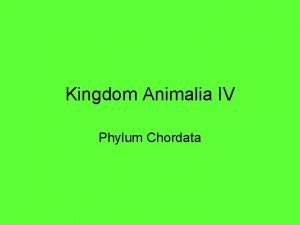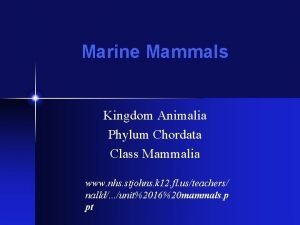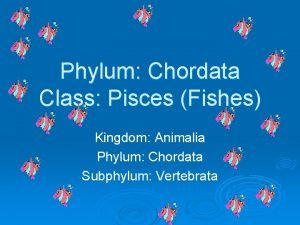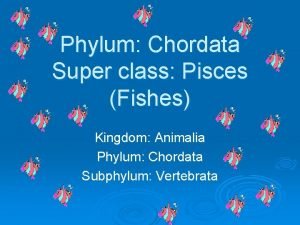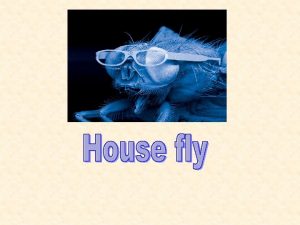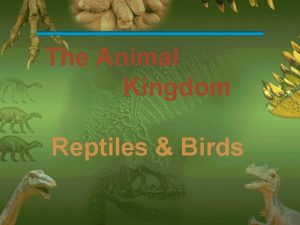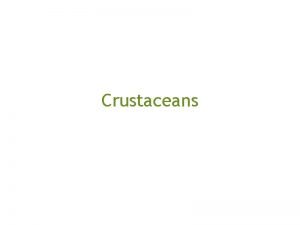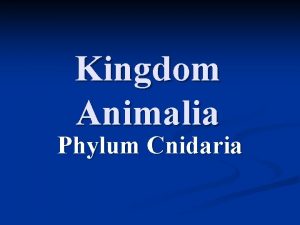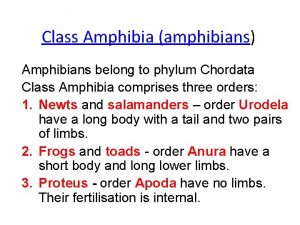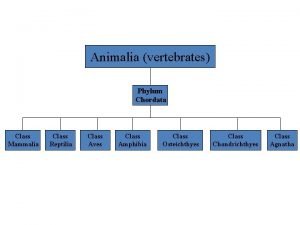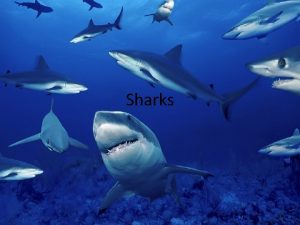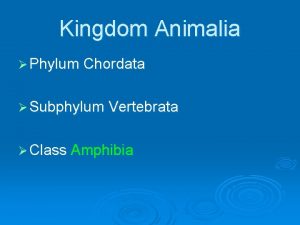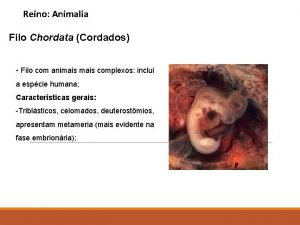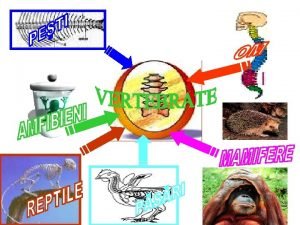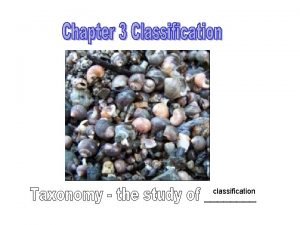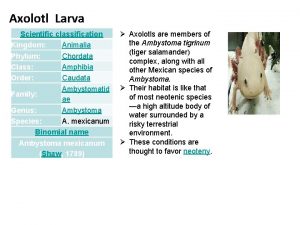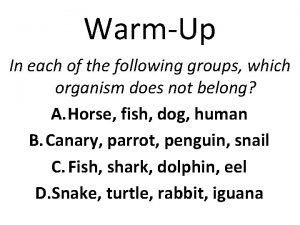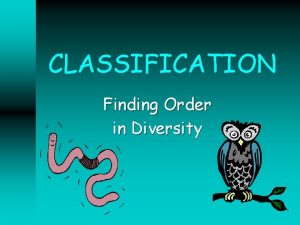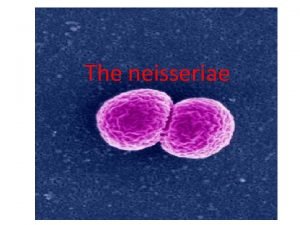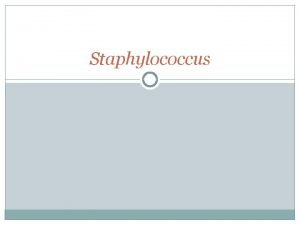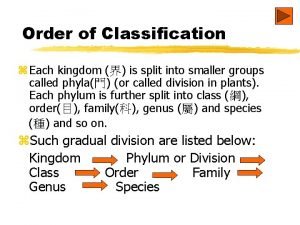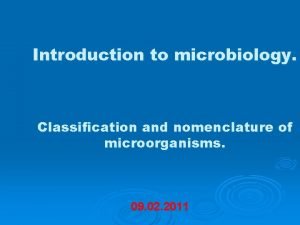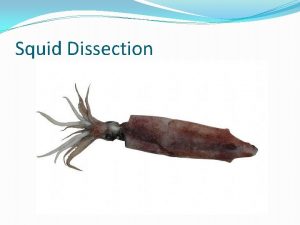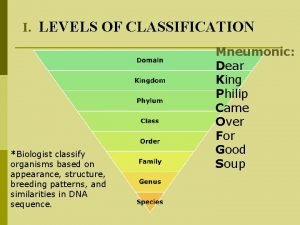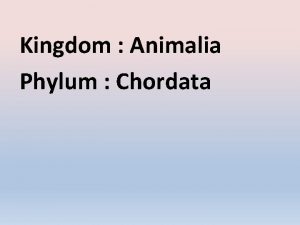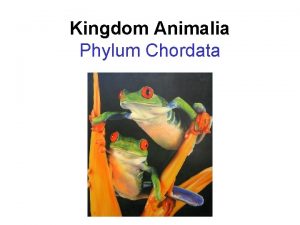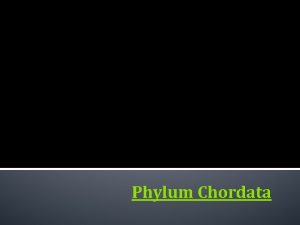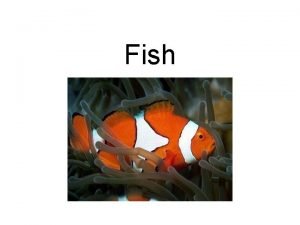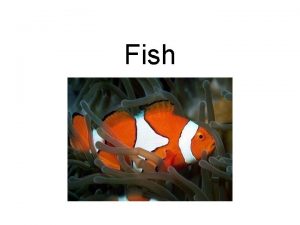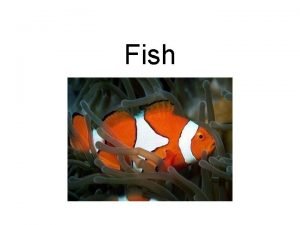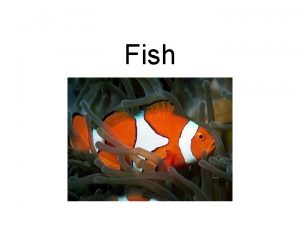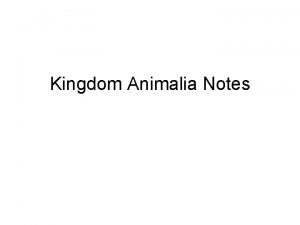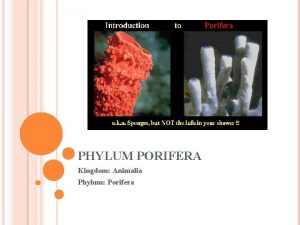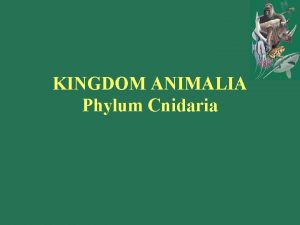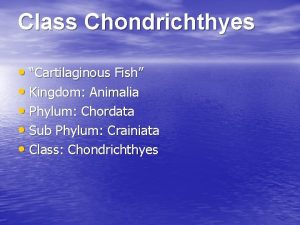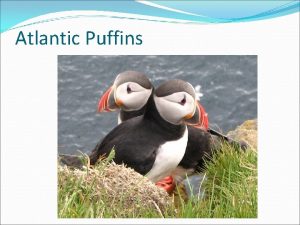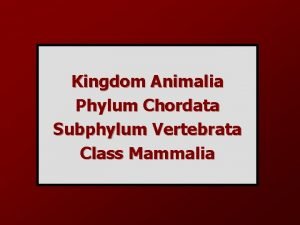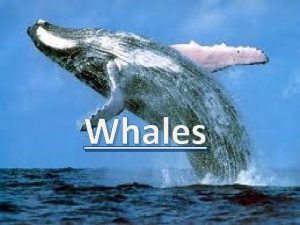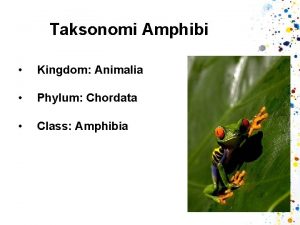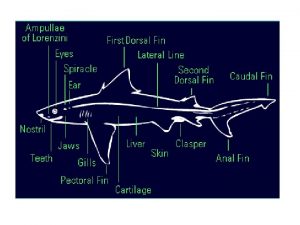Phylum Chordata Super class Pisces Fishes Kingdom Animalia











































- Slides: 43

Phylum: Chordata Super class: Pisces (Fishes) Kingdom: Animalia Phylum: Chordata Subphylum: Vertebrata

I. Characteristics ØA. Most Common 1. Vertebra forms the vertebral column. l 2. Cranium which protects the brain. l 3. Endoskeleton, bone or cartilage. l

Life in the water Ø A. Body plan are well suited for life in the water. l 1. Streamlined shape l 2. Muscular tail l 3. Fins l 4. Gills l 5. Scales have a mucous secretion that protects the fishes from parasites. If scales are present. l 6. Lateral line – rows of sensory pores that run the length of the fishes body on each side and are connected to nerves that pick up vibrations in the water.



ØB. Classes Of Fishes 1. Agnatha – l Jawless l 2. Chondrichthyes – Cartilaginous l 3. Osteichthyes Boney l

1. 2 living species – lampreys and hagfishes *lampreys = 17 species; hagfishes = 43 species. 2. No bony skeleton and no scales. 3. Jawless, Cartilaginous. 4. Has a notochord- remains through life. A notochord generally develops into a backbone in most vertebrates.

a) Hagfish 1. Bottom Dwellers l 2. Two Moveable plates l 3. Rough tongue used to pinch off chunks of flesh of another fish. l 4. Burrows through the body of dead fishes through gills or anus, eating all the internal parts. l




b) Lamprey Ø 1. Spend half it’s life free-living and half as a parasite. Ø 2. Uses it’s disk-shaped mouth with circular rows of sharp teeth to attach to a host and scraps a hole in the flesh, secreting a chemical that keeps the host blood from clotting and feeds on the blood or fluids that leak out. Ø 3. External fertilization



ØChondrichthyes

B. Chondrichthyes – cartilaginous fishes 1. 225 living species – sharks, skates and rays 2. Plate-like scales called Placoid, tooth like spines


B. Sharks Ø 1. Pectoral fins just behind their head Ø 2. Mouth with 6 -20 rows of teeth that point outward. (teeth structure depends on species and feeding habits) Ø 3. Olfactory Bulbs – information from the nostrils is analyzed by the brain, (Keen sense of smell) Ø 4. Sensitive to electrical fields Ø 5. Vision is excellent Ø 6. Largest brain for it’s body size.







C. Adaptations for Cartilaginous fishes Ø 1. Gills are used for gas exchange but requires constant water flow because it does not have an operculum (gill Cover) Ø 2. Rectal Gland – remove excess sodium and chloride ions from the blood and releases them in to the rectum for elimination. (urine)



D. Reproduction in Cartilaginous fishes Ø 1. Internal Fertilization A. Claspers – Males modified pelvic fins and used to transfer sperm into the females body. l B. Some of the fertilized eggs are hatched outside the sharks body and some develop inside the females body. l C. No parental care l





ØOsteichthyes

C. Osteichthyes – bony fishes 1. Strong, lightweight bone 2. 30, 000 + species 3. 2 sub-classes a. Ray-finned fishes – Fins have sharp pointed bones covered with skin. b. Fleshy-finned fishes -lung fishes and lobe fishes 1). Lung fish – Lungs 2). Coelocanth – the front fins are more appendage like, than fin like.



4. External Anatomy of a Boney fish A. Head, trunk and a tail region. Ø B. Operculum – Hard plate, opens at the rear, covers and protects the gills. Ø C. Fins l 1. Caudal – Tail, forward movement l 2. Dorsal – top, Pair, Defense l 3. Anal – below tail, steering l 4. Pelvic – below and behind head, NAVIGATOR l 5. Pectoral – side of the head region, stopping D. Skin – Scales cover, protect, growth rings E. Lateral line – row of sensory pores that detect vibration in the water. Ø


Estimated Years of Perch 4 3 3 2 2 1

5. Internal Anatomy Ø A. Digestive System – 1. Mouth Pharynx, esophagus, stomach, intestines, anus l 2. Accessory organs • A. Liver – produces bile • B. Gall Bladder – stores bile • C. Pancreas – releases enzymes 3. Villi – projections in the intestines that increase the surface area for absorption. l

6. Circulatory Ø A. Closed system Ø B. 2 Chambers, - 1 Atrium and 1 Ventricle. Ø C. 4 parts, - Sinus Venosus, Atrium, Ventricle and Bulbus Arteriosus Ø C. Blood Vessels

7. Respiratory and Excretory functions Ø A. Gills – each gills contains filaments where blood flows across. This arrangement is called COUNTER CURRENT, it allows more oxygen to diffuse. l Gill Rakers – attached to the gills and help prevent food particles from passing through the brachial clefts Ø B. Kidneys – filter and dissolve chemical waste from the blood, carried to the urinary bladder.

8. Swim Bladder Ø A. Bladder that regulates gas for buoyancy in the fish. (Depth at which the fish swims)
 Kingdom animalia phylum chordata class mammalia
Kingdom animalia phylum chordata class mammalia Kingdom animalia phylum chordata
Kingdom animalia phylum chordata Kingdom animalia phylum chordata
Kingdom animalia phylum chordata Kingdom pisces
Kingdom pisces Pisces chordata
Pisces chordata Diptera phylum
Diptera phylum Super class pisces
Super class pisces Animal kingdom phylum chordata
Animal kingdom phylum chordata Kingdom animalia phylum arthropoda
Kingdom animalia phylum arthropoda Digestive system of coelenterates
Digestive system of coelenterates Kingdom animalia phylum cnidaria
Kingdom animalia phylum cnidaria Phylum chordata class amphibia
Phylum chordata class amphibia Phylum chordata class reptilia
Phylum chordata class reptilia Phylum chordata class chondrichthyes
Phylum chordata class chondrichthyes Phylum chordata class amphibia
Phylum chordata class amphibia Reino animalia filo chordata
Reino animalia filo chordata Clasa mammalia
Clasa mammalia Old kingdom middle kingdom new kingdom
Old kingdom middle kingdom new kingdom Old kingdom middle kingdom new kingdom
Old kingdom middle kingdom new kingdom Youtube egypt
Youtube egypt Old kingdom middle kingdom new kingdom
Old kingdom middle kingdom new kingdom Family order genus species
Family order genus species Species genus family order
Species genus family order Euglena domain
Euglena domain Family genus species order
Family genus species order 8 levels of classification in order
8 levels of classification in order Horse phylum classification
Horse phylum classification Kingdom phylum class order of humans
Kingdom phylum class order of humans Kingdom family genus species
Kingdom family genus species 3 domain system of classification
3 domain system of classification Axolotl taxonomic classification
Axolotl taxonomic classification Kingdom phylum class order of humans
Kingdom phylum class order of humans King phillip came over for good soup
King phillip came over for good soup Kingdom phylum class
Kingdom phylum class Neisseria gonorrhoeae kingdom
Neisseria gonorrhoeae kingdom Bacteria kingdom, phylum, class, order
Bacteria kingdom, phylum, class, order Snow leopard kingdom phylum class
Snow leopard kingdom phylum class Platypus kingdom phylum class order
Platypus kingdom phylum class order Kingdom phylum class order family genus and species
Kingdom phylum class order family genus and species Domain kingdom phylum class order family genus species
Domain kingdom phylum class order family genus species Classification schemes of a fungus and a bacterium
Classification schemes of a fungus and a bacterium Taxonomy of a squid
Taxonomy of a squid Classification of cow from kingdom to species
Classification of cow from kingdom to species Which level of classification is the most specific?
Which level of classification is the most specific?

